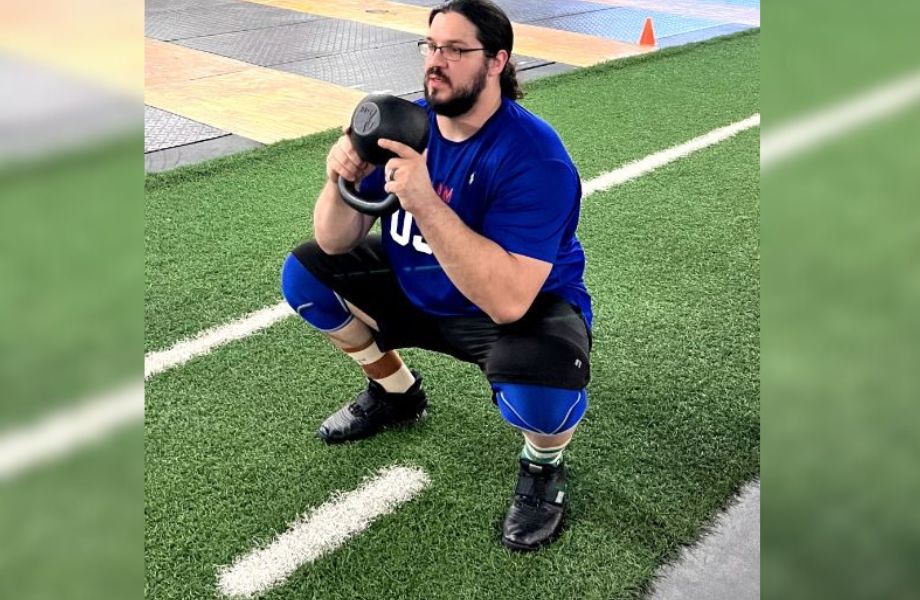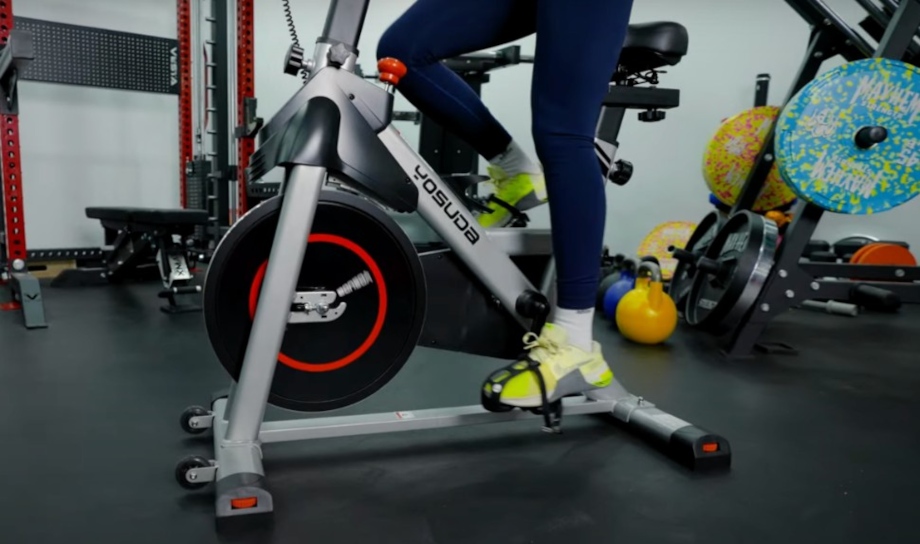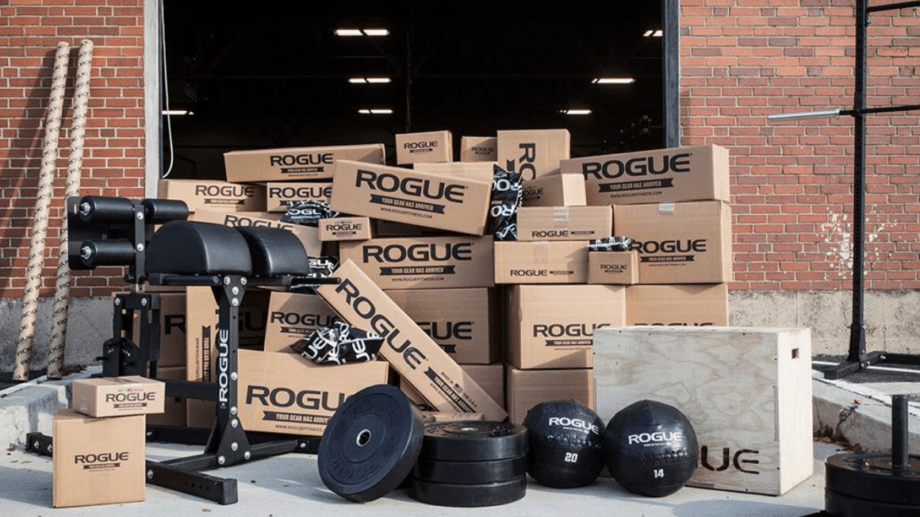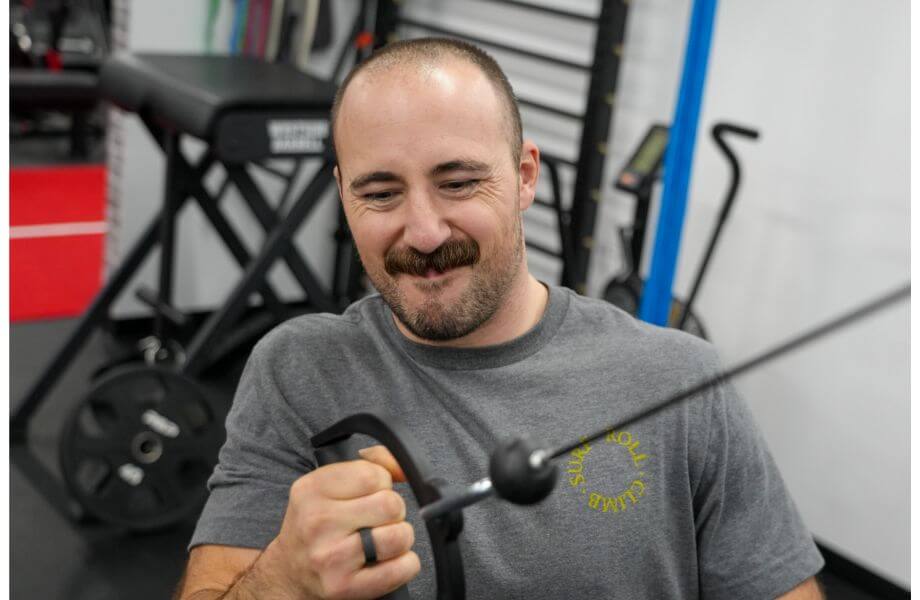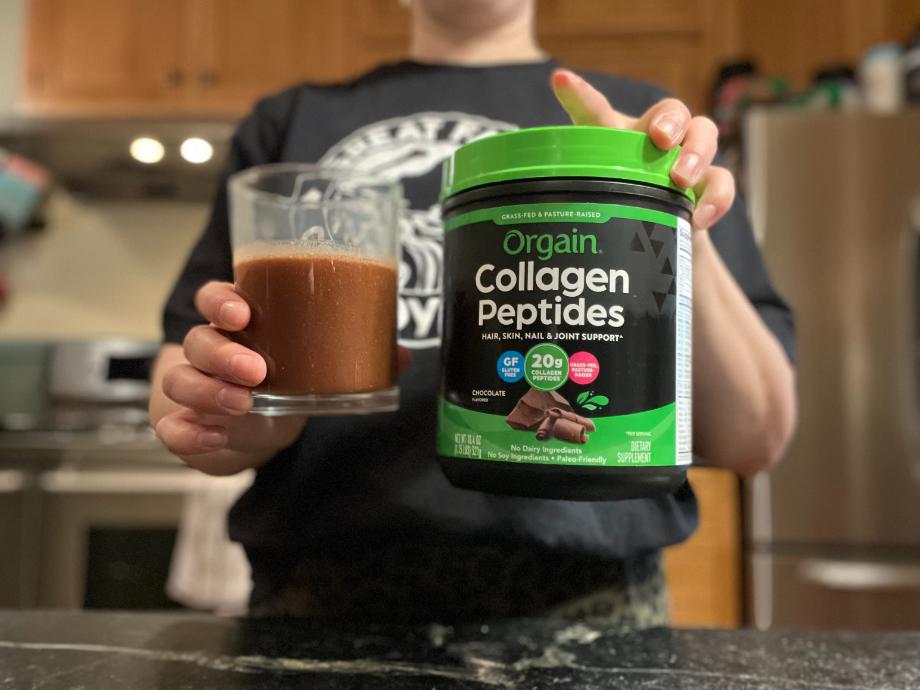Everyone, from experienced fitness enthusiasts to beginners, knows that the squat is one of the be-all-end-all best compound exercises available. Squats build muscle, improve flexibility and mobility, increase lower body strength, and target the abdominals to help build a strong core.
Plus, squats require little to no equipment to perform. Bodyweight squats require only a small section of floor space, and your lovely self, while adding in a single dumbbell or kettlebell ups the ante without the need for a squat rack, barbell, or heavy collection of weight plates on hand.
Today, we’re focusing on kettlebell squats and three of the most popular variations: the goblet squat, the sumo squat, and the front-rack squat. Each requires an adjustment in your technique, and changes the muscle stimulus slightly as well, making them indispensable additions to your “squat arsenal.”
Are you ready to spice up your workout routine with a few of the best kettlebell exercises available?
Grab a kettlebell and let’s begin!
How To Do Kettlebell Squats
If you’re already accustomed to the squat movement, adding a kettlebell should be a breeze, provided you don’t overdo it on the weight. As always, we recommend choosing a lighter weight to start so you can focus on nailing the form first, then gradually increasing the weight as you build comfort and proficiency.
Here’s how to do the goblet squat, sumo squat, and front-rack squats using kettlebells.
Kettlebell Goblet Squats
- Stand with your feet shoulder-width apart and your toes pointing slightly outwards. Cup your hands around the round part of the kettlebell with the handle pointing at the floor.
- Bring the kettlebell into your chest, clutching it tightly against the body. Your elbows should be pointing down, your chest should be tall, and your shoulders should be down and relaxed. This is your starting position.
- Tighten your core and, keeping your back straight, begin lowering your body by bending at the hips and knees. Your weight should be on your heels and your knees should be pointing towards your toes.
- Keep going down until your thighs are parallel to the floor. Make sure your chest remains tall, back stays flat, and your knees do not pass in front of your toes.
- Pause at the bottom of the squat, then, driving from your heels, slowly push back into a standing position.
- Repeat as needed.
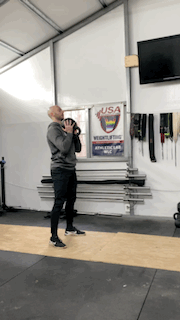
Kettlebell Sumo Squats
- Stand with your feet wider than shoulder-width apart and your toes pointing outwards at a 45-degree angle. You may choose to use a step platform or other means of elevation to allow for a full range of motion.
- Hold the kettlebell by the handle using both hands and a pronated grip. Let it hang between your legs with arms straight.
- Tighten your core and, keeping your back straight, begin lowering your body by bending at the hips and knees. Your weight should be on your heels and your knees should be pointing towards your toes.
- Keep going down until your thighs are parallel to the floor or, if you are not using elevation, the kettlebell taps the floor. Make sure your chest remains tall, back stays flat, and your knees do not pass in front of your toes.
- Pause at the bottom of the squat, then, driving from your heels, slowly push back into a standing position.
- Repeat as needed.
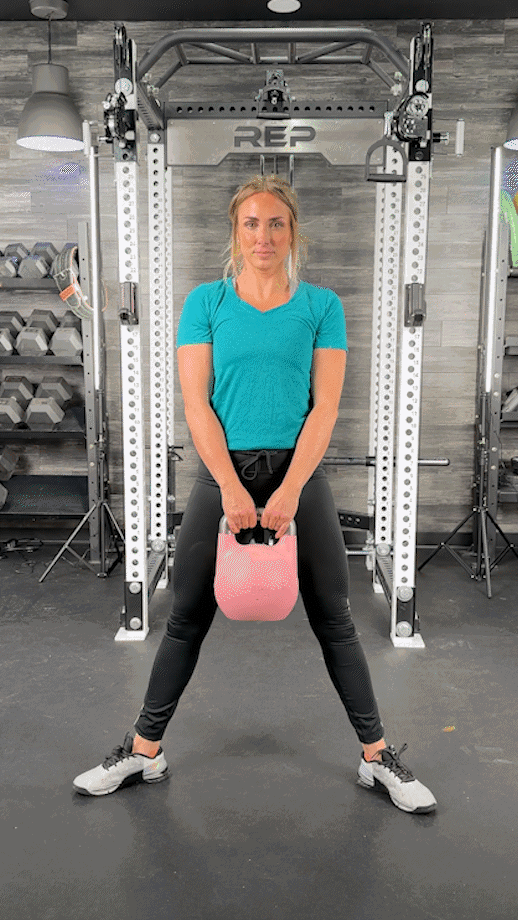
Are single kettlebell sumo squats too easy for you?
As Billy Blanks famously said, “Double time!”
The aptly-named double kettlebell sumo squat, involves grabbing two kettlebells, one in each hand, and performing the squat with the same form as described above.
Because this is an advanced movement, we highly recommend perfecting the single kettlebell sumo squat before graduating to this more challenging version.
RELATED: How To Master The Double Kettlebell Swing
Kettlebell Front-Rack Squats
- Stand with your feet shoulder-width apart and your toes pointing slightly outwards. Hold two kettlebells, one in each hand, by the handles and lift them to chest height, keeping your elbows tucked in close to your body. The kettlebells should be resting on the front of your shoulders with your fingers wrapped around the handles and your wrists straight.
- Tighten your core and, keeping your back straight, begin lowering your body by bending at the hips and knees. Your weight should be on your heels and your knees should be pointing towards your toes.
- Keep going down until your thighs are parallel to the floor or, if you are not using elevation, the kettlebell taps the floor. Make sure your chest remains tall, back stays flat, and your knees do not pass in front of your toes.
- Pause at the bottom of the squat, then, driving from your heels, slowly push back into a standing position.
- Repeat as needed.
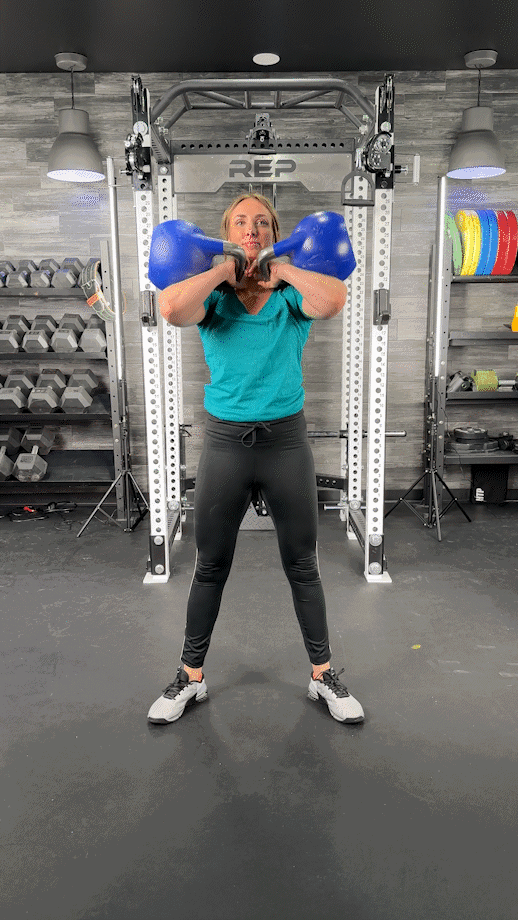
If you’re prone to barbell front squats, overhead presses, or clean and jerks, you’re likely very familiar with the front rack position already. If not, you might find the positioning uncomfortable.
Make sure to keep your chest tall, back flat, and wrists strong, as allowing your wrists to collapse puts stress on the joint and could contribute to or cause injury.
Trainer Tips for Form
The goblet, sumo, and front-rack squats are not identical, but they are all squats. Because of this, the basic movement will be similar across all exercises.
Here are a few trainer tips for proper squat form on these three kettlebell squat variations.
Plant Your Feet
When you’re holding a heavy kettlebell in front of the body, you may feel it pulling you forward, causing you to shift your weight onto your toes. This is no bueno; we want our feet planted firmly and our weight back on our heels.
Maintaining a flat back and holding a tight core will help support the lower back and stabilize the torso, enabling you to maintain a strong posture throughout the squat movement, regardless of which squat variation you’re performing.
It all starts by planting those feet and keeping them in position.
Drive Through the Heels
With your feet firmly planted and your weight back on your heels, you’re now in the prime position to generate force from the legs when rising from your squat.
Keeping the weight on your heels allows for better recruitment in the glutes and hamstrings, two of the primary movers of the squat movement, increasing the amount of force you’re able to produce. It also helps you avoid unnecessary strain on your knees, which decreases your risk of injury.
RELATED: The Best Kettlebell Workouts for Glutes
Keep Your Gaze Forward
Many beginners have a tendency to make intense eye contact with the floor as they push up from the bottom of the squat. However, doing this places your neck and thoracic spine in a precarious position and encourages rounding of the back.
Give yourself your best chance of keeping a strong, straight back, neutral neck and spine, and tall torso by keeping those eyes fixed dead ahead.
Brace Your Core
Bracing your core helps support your lower back and posterior chain muscles, allowing for you to maintain good form and posture throughout each phase of the squat movement.
Losing tension in the core could contribute to a host of other issues like rounding of the back, diminished power pushing out of the squat, and overall increased risk of injury.
Control the Descent
It’s easy, especially at lighter weights,to let gravity do the job for you and just plummet into the bottom of the squat. There are many reasons you want to avoid this.
For one, collapsing into the bottom of the squat robs your body of time under tension, which is what’s going to activate your muscles and provide the stimulus for you to get those sweet gains.
In addition, jerky movements increase your risk of injury, as dropping suddenly could shock your body and cause strain or injury to your lower back, knees, hips, ankles, or other surrounding muscle or muscle group.
Taking your time to control the descent is better for your body and better for your results, too.
Common Kettlebell Squat Mistakes
So, what should you be looking out for during your squat that might spell doom?
Here are some of the most common kettlebell squat mistakes to look out for while you’re working through your set.
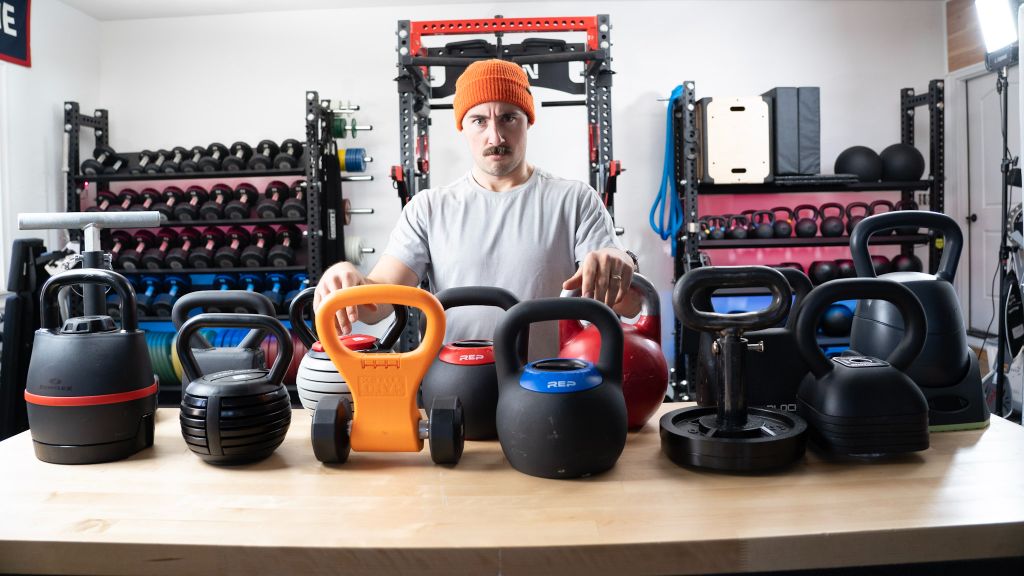
Heels Raising From Ground
Remember, the weight stays on your heels. If you’re not able to lift your toes off the floor and wiggle them at the bottom of your squat, you’ve shifted too much weight forward and you’re at risk of your heels coming off the ground. Not only does this diminish the amount of power you’ll be able to produce when standing back up, it also places strain on the knee and increases your risk of injury.
Focus on keeping your weight back on the heels. If you’re unable to do that, use a lighter kettlebell weight until you can.
Torso Collapsing
A collapsing torso is not good. Losing tension here and crumbling forward causes rounding of the back and improper neck positioning, both reducing the amount of force you’ll effectively generate during the movement and increasing your risk of injury.
To prevent this, keep your core tight and stabilize the midsection to make sure you’re maintaining good form and proper alignment.
Taking a big breath right before you descend into your squat, holding it, then exhaling as you push up from the bottom is a good way to teach yourself to hold tension in the core throughout the exercise.
Looking At the Ground
A lot of people have a tendency to stare at a spot on the floor in front of them as they squat, especially when the weights get heavier and more challenging. We start retreating into our “pain cave” and compromising our good form.
Check in with yourself during the set to make sure you’re keeping your back straight, core tight, neck neutral, and eyes fixed straight ahead.
Looking at the ground puts us in an improper position and could cause us to lose our balance mid-squat. Keeping our gaze focused dead ahead, on the other hand, helps encourage proper alignment and posture, reduces our risk of injury, and keeps our weight back on our heels where it should be.
Knees Collapsing Inward
The knees are an often-overlooked component of the squat movement, but they are integral. Ideally, our knees will create a 90-degree angle at the bottom of the squat and will stay vertically stacked above our toes.
If your knees are collapsing inward as you push up from this position, it’s likely an indicator that you’ve gone too heavy. Don’t practice poor form and risk your health; swap the kettlebell for a lighter one and get in your reps safely.
Kettlebell Squat Variations
So, we’ve gone over each of these three common kettlebell squat variations, and there are many similarities between them, but what makes them different and unique?
Stance
Your stance for the goblet squat and front-rack squat will be very similar, if not identical, but the sumo squat is significantly wider.
Grip
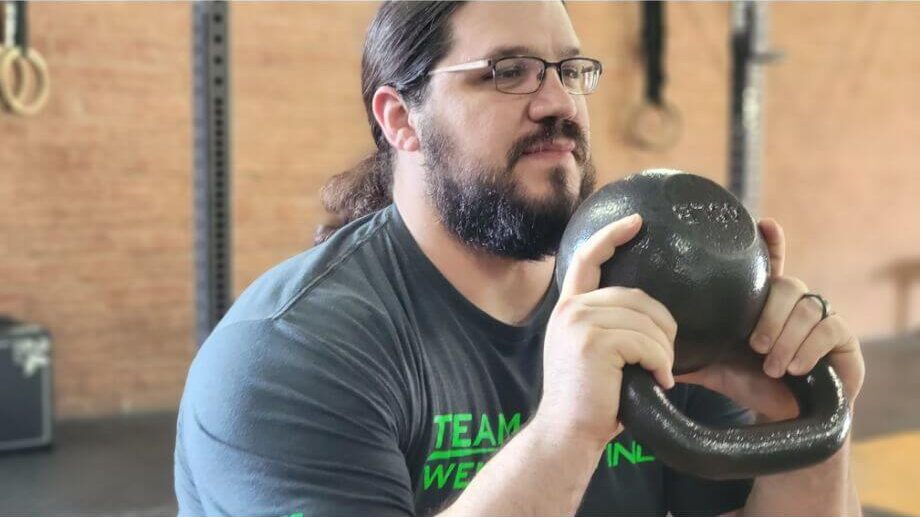
The goblet squat gets its name because you cup your hands around the kettlebell as though you are about to drink from a goblet.
The sumo squat, on the other hand, uses a standard overhand grip, while the front-rack squat uses an overhand grip with the kettlebells hiked up into the front rack position for stability.
Target Muscles
The prime movers of your squat include the quadriceps, hamstrings, and glutes, but the changes in your positioning will alter the muscle activation on each of these variations.
Because you hold the kettlebell close to your chest during the goblet squat, you’ll recruit more upper body muscles like the lats and the biceps.
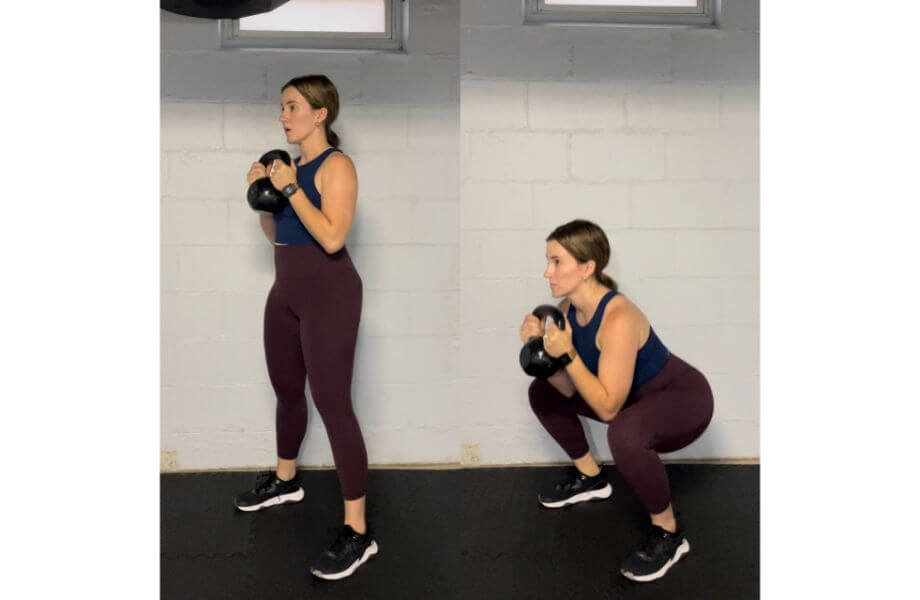
The sumo squat still hits the usual lower body muscles like the quads, glutes, and hammies, but the widened stance provides more activation in the hip adductors and helps improve hip mobility.
RELATED: Improve Your Fitness With The Best Mobility Exercises
Finally, the front-rack squat provides the same squat muscle activation in the lower body and core but, thanks to the front rack position, you’ll get some activation in the upper back and shoulder muscles too.
Range of Motion
Because the goblet squat and front-rack squat require holding the kettlebell at chest level or higher, the kettlebell itself will not impede your range of motion. For this reason, a deeper squat is possible with these two variations.
The sumo squat, on the other hand, requires a wide stance which places the starting position of the kettlebell much closer to the ground. You’ll get a much shorter range of motion because of this, but it can be mitigated by using elevation. Standing on weight plates or a step platform could work.
Then again, the shorter range of motion makes the movement less challenging, making it a good choice for beginners.
Useful Kettlebell Squat Accessories
One of the biggest perks of a full-body kettlebell workout is that it uses a true minimalist approach. All you need is a modest section of floor space and a single kettlebell and exercises like kettlebell squats, kettlebell swings, and kettlebell deadlifts are all at your disposal.
That’s not to say some use of accessories can’t enhance the experience and add a little more oomph to your session. Here are some recommendations that still allow you to take the minimalist approach but provide some additional benefits.
Squat Shoes
Your heels should be planted firmly on the ground when you squat. However, some people have limited ankle mobility, which prevents them from getting a nice, deep squat position without their heels coming up. This can also cause the knees to collapse inward, which can increase the risk of injury.
The best weightlifting shoes are specially designed for squatting, having a hard flat sole, giving you more contact with the floor, and a slightly elevated heel, which improves ankle mobility and gives you the ability to get into a deeper squat position.
Change Plates
Are you looking to get the elevated heel position that squat shoes provide but don’t feel like buying a special pair of shoes just for that?
We get it. One of the most appealing things about kettlebell squats is that you don’t need a lot of stuff to do the job, so buying new shoes kind of works against that goal.
Change plates should do the trick if you want to get an elevated heel position without wearing squat shoes and, since virtually all commercial gyms and many home gyms already have change plates available, it often will require no additional purchase on your part.
Win-win, right?
Wrist Wraps
The best wrist wraps are super useful for keeping your wrists strong and preventing them from collapsing or buckling when you’re holding a heavy kettlebell. They’re inexpensive and could help save you from a slew of nasty injuries like ligament strain or dorsal wrist impingement.
If you’re prone to buckling wrists, save yourself the pain and hassle and buy yourself some quality wrist wraps. Their benefits far outweigh the cost.
FAQs: How to Do Kettlebell Squats
Are squats with a kettlebell effective?
Absolutely. It’s already common knowledge that the squat exercise ranks among the best compound exercises at your disposal in the gym. Adding in resistance, whether it’s a barbell, dumbbell, or kettlebell, increases the benefits of squats, helping provide strength gains and muscular hypertrophy, among numerous other benefits.
What are the benefits of kettlebell squats?
Kettlebell squats provide the same diverse array of benefits as the classic barbell squat, including:
Improved lower body strength
Improved functional strength
Improved cardio fitness
Improved core strength
Improved grip strength
Beyond these general fitness benefits, kettlebells are more convenient and versatile, as you no longer need a big, bulky barbell, giant squat stand or power rack, or a big pile of weight plates to get the job done.
All you need is yourself, a kettlebell or two, and a spot on the floor. That’s what makes it such an attractive addition to those looking to add a simple but effective strength training exercise to their leg workouts.
How heavy should my kettlebell be for squats?
If you’re new to kettlebell training, you don’t want to do too much too soon. Start with a lighter weight to make sure you’re getting the form picture perfect before graduating to heavier weights.
It’s also prudent to consult a certified personal trainer to observe your form and provide a few pointers as you progress. Even seasoned fitness pros could use an outside perspective from time to time in order to keep things tight.
That said, choose a kettlebell weight that challenges you but allows you to keep good form for approximately 12 repetitions. Keeping your sets in the 8 to 12 rep range is usually optimal for stimulating hypertrophy and improving muscle strength.
RELATED: How Many Reps To Build Muscle
How often should I do kettlebell squats?
Kettlebell squats, like all exercises, should not be performed every day. Repeatedly performing the same exercise and targeting the same muscle groups tends not to allow adequate rest and recovery time and could lead to overtraining.
Instead, try working kettlebell squats into the dreaded leg day workout, when you’re already going to perform leg exercises and other lower body focused movements.
Sure, squats provide benefits beyond just the legs, but hitting them on leg day remains one of the most common and effective times to perform them.
Of course, supplement those kettlebell squats with other similar movements like lunges, leg presses, leg extensions, and split squats, to name a few.


